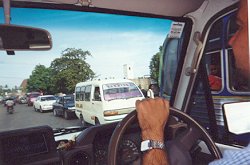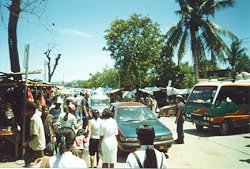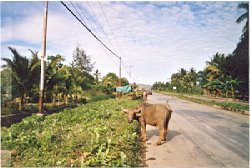
Getting Around in Dili
DILI, February 2001.
THE OVERCROWDING OF DILI was certainly not started by the UN, but it has exacerbated it.
The problem started in the 70's when the TNI, the Indonesian military, began a policy to destroy farm food production in attempt to starve out Falintil, the East Timorese resistance army. The resulting years of famine affected not just Falintil but much of the population and forced large numbers of people off their farms and into Dili, where, by the 1980's some international aid agencies were providing limited food and medical aid.
The population of Dili continued to increase in the 90's when the TNI and the militia, those East Timorese and 'resettled' Indonesians who supported political integration with Indonesia, began their campaign of intimidation. Prior to the August 1999 UN referendum, dozens of pro-independence towns like Liquica and Maliana were scenes of mass killings. The intent of this horrible strategy was to cow people into voting for integration. While it didn't stop a 72.8% vote for independence, it effectively emptied many of these towns into the streets of Dili, and many of those people have remained here.
Along with all these displaced Timorese, Dili is now the home of thousands of UN staff and volunteers as well all those who work in the 70-odd international agencies that are here to 'develop' East Timor. Just the presence of these malaes attracts people because they hope that some of their money will "trickle down".
The current overcrowding of Dili is well illustrated by the traffic. Even a year ago I'm told there was no traffic problem. Now, during daylight hours, there is constant congestion and bumper to bumper traffic from the middle of the city right out to the airport.
 The vehicles are of an incredible variety. They can be categorised as
public transportation (bemos, taxis and intercity buses), UN vehicles
(4WDs, heavy trucks and weird looking military carriers), aid agency
vehicles (dual cab Hi Ace pick-ups, Toyota Surfs, Land Rovers) and private
vehicles (every kind of truck, car, motorbike, scooter and bicycle imaginable).
The vehicles are of an incredible variety. They can be categorised as
public transportation (bemos, taxis and intercity buses), UN vehicles
(4WDs, heavy trucks and weird looking military carriers), aid agency
vehicles (dual cab Hi Ace pick-ups, Toyota Surfs, Land Rovers) and private
vehicles (every kind of truck, car, motorbike, scooter and bicycle imaginable).
The bemos are private vans that are the Dili's free market bus service. These tend to be crowded little numbers that travel the arteries of Dili carrying people for a flat rate of 1,000 rupiah or 20 Australian cents.
Taxis are simply cars with male drivers cruising around tooting their horns to indicate they are looking for a fare. There are hundreds of these that operate until about 8:30 at night, which is often earlier than you want to be home. There are no meters so the fare is by negotiation: generally $A2 for the average lift.
By contrast, it will only cost you $A4 to get to Baucau on a bus, but plan on a crowded, six to seven hour journey that only takes a leisurely three and a half hours in a four wheel drive.
Driving is a relatively new skill for the East Timorese and considering there are no driving schools, no drivers licences, no vehicle registration and no road rules, they do pretty well.
 About a third of the vehicles on the road have no number plates. Those
that do, have the plates of the state they came from, often the Northern
Territory, Queensland or somewhere in Europe, or they have a number plate
of the organisation that owns or sponsors them. For example UNTAET, the
government, has its own number plates that, one assumes, reflects its own
database of what appears to be a fleet of over 1,700 vehicles.
About a third of the vehicles on the road have no number plates. Those
that do, have the plates of the state they came from, often the Northern
Territory, Queensland or somewhere in Europe, or they have a number plate
of the organisation that owns or sponsors them. For example UNTAET, the
government, has its own number plates that, one assumes, reflects its own
database of what appears to be a fleet of over 1,700 vehicles.
The traffic in Dili is quite different from 'western' traffic. In western traffic you feel that once you've established your place in your lane, it's yours. Not so in East Timor. If someone wants to travel faster than you, they honk their horn and then pass. Overtaking is a constant element of driving, here, as drivers don't slow down, they go around. That often means vehicles overtake on quite narrow streets. In fact, there are no wide streets and the oncoming traffic rather organically veers over to make room. It's also quite common for vehicles, especially motorbikes, to travel for long stretches on the shoulder on wrong side of the road, even when there is a lot of traffic.
Interestingly, there is little agro on these streets although traffic accidents can attract volatile crowds, especially if a malae driver in involved. The most reckless and aggressive drivers are a minority of UNTAET drivers who race madly around Dili and the countryside.
There are no seatbelt, helmet or enforced drink driving laws, either. I heard a UN worker last night say that he had only had two beers and wasn't allowed to drive until he'd had his third. It was said as a joke but it's a comment about many people's disregard for safety practice here that they would exhibit at home. And me, I caged a lift from him because it was after 8:30 and I couldn't find a taxi!
One thing about no warrant of fitness for vehicles is that many trucks, cars and motorbikes, and quite literally no bicycles, have lights. This makes night driving rather … exciting. Maybe this is why it's so hard to find a taxi in the evening: taxi drivers are unwilling to risk their cars to the perils of night driving in East Timor.
Two weeks on, my Dengue Fever is gone. I'm not quite up to normal speed but I'm no longer sick.

Another of Dili's traffic hazards - a water buffalo
during his time in Timor

• HOME
• 1 First Impressions
• 2 Beginning to See Part of the Picture
• 3 Don't Mistake Poverty for Quaint
• 4 What Am I Doing Here?
• 5 Smoke & Refugees
• 6 Good Aid/Bad Aid
• 7 The Healthiest One in the Ward
• 8 Getting Around in Dili
• 9 No Work and You Don't Get Paid
• 10 Four Languages, Four Currencies
• 11 Just Below the Surface
• 12 As Hard Leaving as Arriving
• 13 Don't Get the Wrong Impression
• Photos